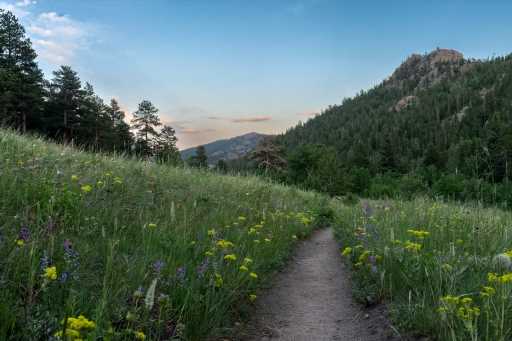
Wildflower season does not last long in Colorado but in those years when spring brings abundant rain or late-season snow, the flowers pop like crazy. This was one of those years, and there is still time to catch the last of the color.
One trail ideal for checking out meadows of wildflowers with a bonus waterfall at the end is Bridal Veil Falls.
Located in the northeast corner of Rocky Mountain National Park north of Lumpy Ridge, the Bridal Veil Falls trail is a 6.2 out-and-back hike with minimal elevation gain of 964 feet. Be wary of this slight elevation gain; much of it is in the thick forest and rocky gorge of the last mile, thus giving the trail its moderately challenging classification.
Start the hike at the Cow Creek Trailhead, which is located at the historic McGraw Ranch at the end of McGraw Ranch Road.
The beginning of the hike, which starts at 7,837 feet, passes the original ranch lodge, barn and cabins, now used as housing for researchers for Rocky Mountain National Park.

Follow the flat, two-track dirt road through the ranch onto the Bridal Veil Falls trail. The trail will continue into the open meadows of Cow Creek Valley flanked by large granite crags and conifer forest on either side. The meadows along the trail fill with a variety of wildflowers, including black-eyed Susan, wild geranium, gaillardia, bluebells, locoweed, golden banner, lupine, paintbrush, wild rose, columbine and fireweed, in late June, July and early August.
Hike past the junction for North Boundary Trail and then the junction for Gem Lake and Balanced Rock a little farther up the trail.
Continue west through more open meadows, looking for mule deer and wild turkeys as you hike, to the junction for Bridal Veil Falls Trail, which splits to the northwest. Take in the views of McGregor and Dark Mountains along this stretch.
Here the trail starts navigating through thicker forest and begins to climb as it continues to follow the drainage of Cow Creek. Stop to enjoy the smaller waterfalls along this section of the trail but don’t give up for the larger waterfall at the end of the hike.
Continue to follow the trail through the forest and then as it climbs along some steep rock slabs into a granite gorge. The last section of the trail is a bit of a rock scramble, rising more than 100 feet in the last tenth-of-a-mile.
The effort pays off when you reach the 20-feet of cascading water of Bridal Veil Falls.
Although wildlife seems more timid in this section of the park, animals do live here. All of the meadows and forest edges are ideal locations to watch for birds, such as downy woodpeckers, northern flickers, sapsuckers and broad-tailed hummingbirds. The areas near the waterfall and smaller cascades attract American dippers. Black bears may feed on the choke cherries in late summer, and moose and elk may navigate through the area in fall and winter. And of course the smaller mammals, such as chipmunks, golden-mantled ground squirrels and mountain cottontails, bound around the trail hoping for crumbs from hikers.
In addition to July for wildflowers, June is a great time to hike this route when the snow melt causes the creek to rise and the waterfall to flow at its peak. In dry summers, the waterfall may have very low water flow. Taking this hike in fall offers an opportunity to enjoy the autumn foliage of the aspen trees.
Bridal Veil Falls can also be accessed by starting at the Lumpy Ridge Trailhead. This option extends the hike to more than 15 miles. Or hike the Lumpy Loop and add Bridal Veil Falls as a two-mile detour to make the full hike almost 13 miles.
Subscribe to our weekly newsletter, The Adventurist, to get outdoors news sent straight to your inbox.
Source: Read Full Article









